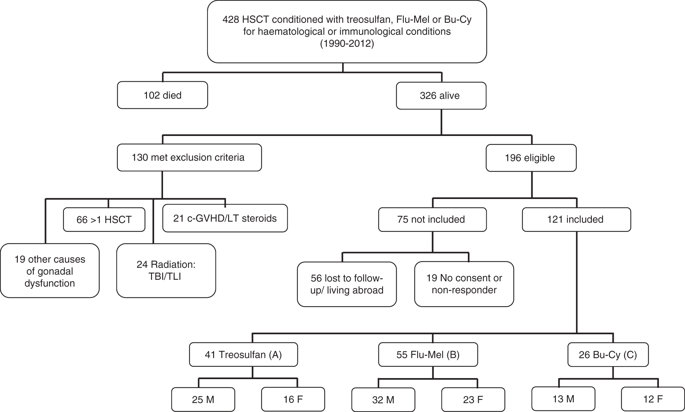当前位置:
X-MOL 学术
›
Bone Marrow Transpl.
›
论文详情
Our official English website, www.x-mol.net, welcomes your feedback! (Note: you will need to create a separate account there.)
Anti-Müllerian hormone and Inhibin B after stem cell transplant in childhood: a comparison of myeloablative, reduced intensity and treosulfan-based chemotherapy regimens.
Bone Marrow Transplantation ( IF 4.8 ) Pub Date : 2020-03-30 , DOI: 10.1038/s41409-020-0866-9 Alison Leiper 1 , Maite Houwing 2 , E Graham Davies 3, 4 , Kanchan Rao 3 , Siobhan Burns 5 , Emma Morris 5 , Joop Laven 6 , Anne-Lotte van der Kooi 6 , Marry van den Heuvel Eibrink 7 , Stephen Nussey 8
Bone Marrow Transplantation ( IF 4.8 ) Pub Date : 2020-03-30 , DOI: 10.1038/s41409-020-0866-9 Alison Leiper 1 , Maite Houwing 2 , E Graham Davies 3, 4 , Kanchan Rao 3 , Siobhan Burns 5 , Emma Morris 5 , Joop Laven 6 , Anne-Lotte van der Kooi 6 , Marry van den Heuvel Eibrink 7 , Stephen Nussey 8
Affiliation

|
Serum concentrations of Anti-Müllerian hormone (AMH) and Inhibin B were used to assess potential fertility in survivors of childhood haematopoietic stem cell transplantation (HSCT) after three chemotherapy-conditioning regimens of differing intensity. Of 428 patients transplanted between 1990-2012 for leukaemia and immunodeficiency 121 surviving >1 year after a single HSCT were recruited. Group A had a treosulfan-based regimen (low-toxicity); Group B had fludarabine/melphalan (Flu-Mel) (reduced-intensity) and Group C had busulphan/cyclophosphamide (Bu-Cy) (myelo-ablative). Mean age at HSCT and follow-up and length of follow-up were 3.6, 11.8 and 9.9 years. Mean AMH standard deviation scores (SDS) were significantly higher in Group A (-1.047) and Group B (-1.255) than Group C (-1.543), suggesting less ovarian reserve impairment after treosulfan and Flu-Mel than after Bu-Cy. Mean serum AMH concentration was significantly better with treosulfan (>1.0 μg/l) than with Flu-Mel or Bu-Cy. In males, mean Inhibin B SDS was significantly higher in Group A (-0.506) than in Group B (-2.53) and Group C (-1.23) with the Flu-Mel group suffering greatest impairment. In conclusion, a treosulfan-based regimen confers a more favourable outlook for gonadal reserve than Flu-Mel or Bu-Cy in both sexes. Higher values of Inhibin B after Bu-Cy than after Flu-Mel may reflect recovery over time.
中文翻译:

儿童干细胞移植后的抗苗勒管激素和抑制素B:清髓性,降低强度和基于硫代砜的化疗方案的比较。
在三种强度不同的化疗条件下,使用抗苗勒管激素(AMH)和抑制素B的血清浓度评估儿童造血干细胞移植(HSCT)幸存者的潜在生育能力。在1990年至2012年之间因白血病和免疫缺陷而移植的428名患者中,有121名在单次HSCT后存活> 1年存活。A组采用基于硫磺的方案(低毒);B组具有氟达拉滨/美法仑(Flu-Mel)(强度降低),C组具有丁苯丙氨酸/环磷酰胺(Bu-Cy)(清髓性)。HSCT和随访的平均年龄以及随访时间分别为3.6、11.8和9.9岁。A组(-1.047)和B组(-1.255)的平均AMH标准差评分(SDS)明显高于C组(-1.543),这表明,在使用硫丹和Flu-Mel后,卵巢储备损害要比在Bu-Cy后少。硫代硫丹(> 1.0μg/ l)的平均血清AMH浓度明显优于Flu-Mel或Bu-Cy。在男性中,A组(-0.506)的平均抑制素B SDS显着高于B组(-2.53)和C组(-1.23),其中Flu-Mel组遭受的损害最大。总之,基于二硫的治疗方案在两性方面都比Flu-Mel或Bu-Cy更有利于性腺储备。Bu-Cy后的抑制素B值高于Flu-Mel后的抑制素B值,可能反映了随着时间的恢复。23)Flu-Mel组受损最大。总之,基于二硫的治疗方案在两性方面都比Flu-Mel或Bu-Cy提供更好的性腺储备前景。Bu-Cy后的抑制素B值高于Flu-Mel后的抑制素B值,可能反映了随着时间的恢复。23)Flu-Mel组遭受的损害最大。总之,基于二硫Flu的治疗方案在两性方面都比Flu-Mel或Bu-Cy更有利于性腺储备。Bu-Cy后的抑制素B值高于Flu-Mel后的抑制素B值,可能反映了随着时间的恢复。
更新日期:2020-04-24
中文翻译:

儿童干细胞移植后的抗苗勒管激素和抑制素B:清髓性,降低强度和基于硫代砜的化疗方案的比较。
在三种强度不同的化疗条件下,使用抗苗勒管激素(AMH)和抑制素B的血清浓度评估儿童造血干细胞移植(HSCT)幸存者的潜在生育能力。在1990年至2012年之间因白血病和免疫缺陷而移植的428名患者中,有121名在单次HSCT后存活> 1年存活。A组采用基于硫磺的方案(低毒);B组具有氟达拉滨/美法仑(Flu-Mel)(强度降低),C组具有丁苯丙氨酸/环磷酰胺(Bu-Cy)(清髓性)。HSCT和随访的平均年龄以及随访时间分别为3.6、11.8和9.9岁。A组(-1.047)和B组(-1.255)的平均AMH标准差评分(SDS)明显高于C组(-1.543),这表明,在使用硫丹和Flu-Mel后,卵巢储备损害要比在Bu-Cy后少。硫代硫丹(> 1.0μg/ l)的平均血清AMH浓度明显优于Flu-Mel或Bu-Cy。在男性中,A组(-0.506)的平均抑制素B SDS显着高于B组(-2.53)和C组(-1.23),其中Flu-Mel组遭受的损害最大。总之,基于二硫的治疗方案在两性方面都比Flu-Mel或Bu-Cy更有利于性腺储备。Bu-Cy后的抑制素B值高于Flu-Mel后的抑制素B值,可能反映了随着时间的恢复。23)Flu-Mel组受损最大。总之,基于二硫的治疗方案在两性方面都比Flu-Mel或Bu-Cy提供更好的性腺储备前景。Bu-Cy后的抑制素B值高于Flu-Mel后的抑制素B值,可能反映了随着时间的恢复。23)Flu-Mel组遭受的损害最大。总之,基于二硫Flu的治疗方案在两性方面都比Flu-Mel或Bu-Cy更有利于性腺储备。Bu-Cy后的抑制素B值高于Flu-Mel后的抑制素B值,可能反映了随着时间的恢复。


























 京公网安备 11010802027423号
京公网安备 11010802027423号